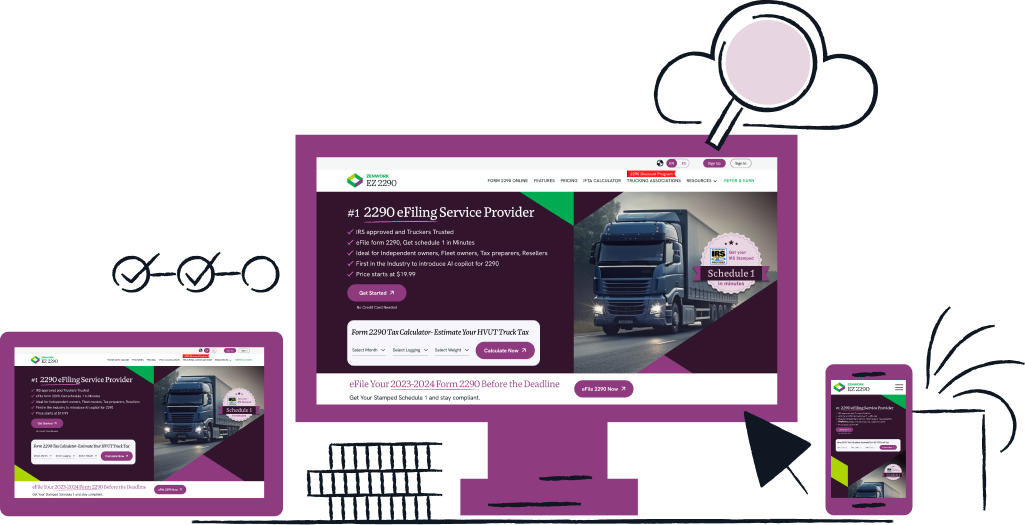File IRS Form 2290 Online and
Get Schedule 1 in Minutes
- Free VIN Corrections
- Free Retransmission
- AI Copilot for 2290


Quickly determine your exact HVUT tax amount before filing. Our calculator provides instant Form 2290 tax estimates based on your vehicle specifications.
eFile IRS Form 2290 and related HVUT tax forms quickly and securely with EZ2290. Enjoy a simple, guided process designed for truckers, fleets, and tax professionals.

Report your vehicle information for the current period by eFiling Form 2290

Amend your previous 2290 reports by eFiling a 2290 Amendment.

Request a credit claim from the IRS by eFiling Form 8849

Easily correct an incorrect VIN by reporting with Form 2290
EZ2290 offers powerful tools and protections designed specifically for trucking businesses. Experience these premium features with every filing.

Our user guides, personalized 2290 eFiling services, TIN, VIN Lookup, and 2290 amendments help you from being penalized by the IRS.

EZ2290 is secured with a 256-bit advanced encryption standard, making it the safest platform for transmitting your 2290 tax returns to the IRS securely.

Our smart 2290 tax calculator automatically calculates the total HVUT tax you owe when you populate the 2290 form with the necessary information.

eFile Form 2290 for multiple vehicles at once with bulk uploads. EZ2290 automatically populates the data across the 2290 forms appropriately
Select the filing option that works best for you. Whether you’re a returning user, have a previous Schedule-1, or are filing for the first time, we’ve got you covered.

eFile Form 2290 online securely through IRS compliant 256-bit bank-grade security standards and advanced high-end data encrypted EZ2290 eFiling platform.

EZ2290 is designed to suit the HVUT compliance needs of different kinds of trucking businesses. File 2290 online and get IRS stamped Schedule 1 in minutes

EZ2290 allows you to check the status of your 2290 filings in real-time and manage your eFilings easily. We also offer a free re-file for rejected form 2290 returns.

With EZ2290 24×7 2290 tax filing support, you can get live resolutions to your technical and 2290 tax-related queries quickly from our expert team.
IRS Form 2290 (Heavy Vehicle Use Tax) online filing is a very easy process with IRS authorized eFile service provider EZ2290.
eFile 2290 now and get your IRS stamped HVUT Schedule 1 within minutes.
Get Started NowNo credit card required



With our smart features and live truck tax assistance, you can eFile your Form 2290 returns in just a few minutes.
Start 2290 eFile Now Calculate HVUT

Do It Yourself 2290 eFiling program is for filers who have a few number of 2290 forms to eFile
Our expert 2290 tax filing team will coordinate with your accounting team or representatives to eFile 2290 forms on your behalf.

EZ2290 is a digital 2290 filing platform enabling 10,000+ truckers, trucking companies, and fleet owners to file thousands of 2290 forms electronically every year. Create a free account to get started.
Our 3-step eFile process simplifies 2290 filing, enabling you to import your tax-sensitized data, validate the reports, and e-File Form 2290 online in just a few quick moments.
EZ2290’s Bulk Filing service is a simplified 2290 filing solution for large fleet companies who need to file hundreds or maybe even thousands of 2290 forms for their trucks at once. With EZ2290,you can eFile bulk 2290 forms in a single click, saving you time and effort.
EZ2290’s Premium Service is for large fleet owners and trucking companies that need to file thousands of 2290 forms around the year.
Priced at $199.99 a year, EZ2290 Premium Service features:
Note: EZ2290 Premium Service is valid for just one business entity. If you’re a preparer, you may need to purchase the premium service separately for each entity.
Yes. If you’ve previously eFiled a Form 2290 with EZ2290, and if the IRS happens to reject your 2290 returns citing incorrect VINs, then you can file a VIN Correction form with EZ2290 at no additional cost.
If you’ve previously filed your 2290 returns electronically with EZ2290, and if the IRS happens to reject your returns citing incorrect information or any other reporting issue, tax experts at EZ2290 will provide the necessary assistance to find precise resolutions.
Once the corrected forms have been reviewed by your teams for accuracy and relevance, our teams review the forms (just to be extra sure) and help you eFile the corrected 2290 returns instantly.
When you eFile with EZ2290, you don’t have to wait for hours to receive your IRS-stamped Schedule 1. You receive it instantly, right after EZ2290 successfully submits your 2290 returns to the IRS.
In just a matter of seconds, you’ll receive a digital equivalent of the IRS-Stamped Schedule 1, which is authenticated by the IRS and just as valid as a physical copy of the schedule.
Filers may need to eFile Form 2290 Amendment if the taxable gross weight of the vehicle has increased or if the suspended vehicles have exceeded the mileage use limit. 2290 Amendment form is specifically meant for reporting these two variables since both these factors affect the total tax burden on the entity or truck owner. Do not use the 2290 Amendment form for any other reason.
The 2290 Amendment is not a new form but it needs to be filed separately. You just need to select the ‘Amended Return’ box on Form 2290 to signify that the 2290 form is being filed exclusively for amendment.